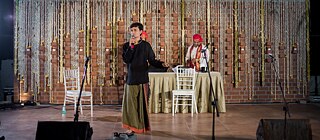Flaws?
Err Fashionably, and Look Hot!
To err by making fashion statements that don’t abide by societal norms is no longer pertinent. Young Indians, of all gender identities and expressions, are sporting looks to elicit awe, finds Nirmala Govindarajan.
In an era where time-tested normative dress definitions have begun to blur, beauty, fashion, and lifestyle draw nourishment from fluid gender expressions. And queer culture has always had a huge influence on the global fashion industry, points out multi-disciplinary artist Masoom Parmar.
From Closet to Cinema and Catwalk
“You may love it or hate it, but you definitely cannot ignore it. Fashion designer Manish Arora’s psychedelic aesthetic has consistently carried queer undertones, with splashes of neon colors and whimsical patterns, since he founded his eponymous brand in 1997. Rohit Bal’s 2003 Lakmé Fashion Week show has had male models in skirts sporting sindoor (vermillion) and nose rings – an indication of men being in touch with their feminine sides. In effect, Indian fashion is increasingly becoming non-binary,” explains Masoom. “The current Bollywood heartthrob Ranveer Singh wears skirts and boots, Mr. Perfectionist Aamir Khan wears kajal (mascara) and pierces his nose, and the nation laps it up. The kediyu (a long-sleeved upper garment pleated at the chest), which is now a fashion statement for women, has traditionally been worn, and still continues to be adorned by men in rural Gujarat and Rajasthan.”
Masoom is heartened by this trend. “But, let’s not forget queer men did it before, be it sporting kajal, wearing skirts or boots, or flaunting that nose pin,” he emphasizes. “We have been there, done that! We knew fashion way before they became trends. Back in the early 2000s, when I started piercing my ears (I have 13 now! Ten in one ear and three in the other), I was asked by well-meaning friends and not-so-well-meaning relatives if I was doing this to get in touch with my feminine side! I was teased when I replaced my denims with lungis (a length of cloth wrapped around the waist, covering the lower body till the ankles) and sarongs in the year 2013. Both ear piercings and sarongs are now the ‘in’ things. Now, those relatives don’t tire of praising me for my sartorial choices. Heck, they even come for advice!”
With fashion trends transcending the binaries of expression, Yogita, a social development worker and communications consultant talks of the painful effects of tattooing herself. And no, we are not talking of the physical pain of getting tattooed, which, according to Yogita, is bearable.
The Funny in the “Flaw”
The “funniest thing” that happened to Yogita since she began her tryst with tattoos was her grandmother and mom boycotting her for weeks – over a tattoo that she hadn’t told them about for months anyway! “They would walk away every time they saw me as though the idea of me having gotten an indelible design on my body without their permission, as an adult, was woe befallen on them,” she reminisces. “It was so dramatic, it felt like a late-’80s Hindi sitcom! And it could have successfully been one!”
That’s not all – after Yogita got her third tattoo inked, half a golden snitch from the Potterverse on her hand and the other half on her female best friend’s hand, assumptions catapulted into definitive statements. Yogita was definitely lesbian, people would say. “In fact, an uncle asked whether I was one of ‘those female gays,’ trying hard not to offend me, but somehow looking quite offended himself. Of course, back in 2015, I thought this was an Indian phenomenon – but no. When I was in the UK studying, the smartest man I knew was bewildered that I wasn’t lesbian (first of all, why did anyone care if I was). His reasoning? I was outspoken about fluid identities, and apparently, seeing a picture of my tattoo with this girlfriend of mine must have meant that I was lesbian. Needless to say, this ended in a very awkward silent bus journey because what do you tell a man? ‘Umm… No, sorry, I don’t fit your fantasy anymore?’ This was hilarious and disappointing all at once – especially after a few weeks of kissing him!”
While Yogita believes in individualistic fashion statements that find no congruence with gender, she does feel that globally some recent fashion statements may have gone all wrong.
The Fashion Statement that Went Awry
“Really, what was Lady Gaga’s meat dress about? I still don’t get it!” exclaims Yogita. Well, Lady Gaga later went on record on The Ellen DeGeneres Show to explain that the “meat dress” she wore to the MTV Video Music Awards was to protest the way the American Army treats its gay soldiers – it certainly wasn’t to show disrespect to vegans and vegetarians. “Well,” sighs Yogita, “I think Lady Gaga just made it worse by justifying her outfit as a statement ‘for what one believes in,’ and why the ‘meat dress’ was against the US military’s gender-conforming policies. There was nothing cool about that dress whatsoever! Honestly, Miley Cyrus probably made a better statement in her ‘Wrecking Ball’ music video than Lady Gaga did!”
Well, speaking of statements that singers make, Chennai-based, man bun-wearing musician Achintya Vathul, free-spirited as his choice of career is, sports an equally bohemian mane.
Set You Up with a Butcher Shop
Achintya’s lovingly cultivated mane has been the butt of jokes in his family for the better part of the pandemic. Albeit, in the form of nonchalant second-nature religious prejudices being hurled at him, the comments masquerading as humor. “Setting all that aside for a moment, I would’ve had a hard time buying the idea that there would ever be a point in my life when I would grow my hair out,” confirms Achintya. “I was ferociously averse to the idea of sporting long hair owing to lack of imagination and the spirit to experiment. But when I decided to go for it, there was this newfound excitement of a strange nature that comes with doing something with yourself for the first time, and initially, that confounded me entirely. Now, I am just downright loving my long hair.”
What’s more, Achintya’s long hair has made his mother very happy, much to his dismay. “Especially so, given that I always expect my parents to lose it when I make lifestyle and fashion choices that aren’t normative. But, contrary to my expectation, my mother is very happy with my mane – she claims she has a daughter whose hair she can braid!”
However, not everyone in Achintya’s circles shares his mother’s sentiment. “Many people wanted to set me up with a butcher shop since I looked like my fellow Muslim countrymen. This attitude just goes on to impress upon the visual and religious prejudices that exist in everyday lives, people showing their disapproval in the form of offhanded statements made within the confines of a family gathering.”
Feel-Good Fashion
With acceptance and criticism, Achintya confesses he’s had good company in the “debutant hair growers department,” owing to the pandemic being the “ultimate fashion experiment catalyst.” “Perhaps the most important takeaway of sporting a long mane is that it makes me, and all of us doing it, feel good. And that’s that!” Well, that’s fashionable enough, Achintya!


